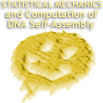Speaker
Dr
Lulu Qian
(Caltech)
Description
Not long after Adleman showed that DNA can serve as a
computing substrate, Baum proposed using DNA to build an
associative memory larger than the brain. Attempts to bring
these ideas to fruition have been hindered by requirements
for enzymes or manual experimental steps. Here our interest
is in DNA strand displacement circuits that can perform
neural network computation autonomously. We make use of a
simple DNA gate architecture that has recently allowed
experimental scale-up of multilayer digital circuits. We
developed a systematic procedure for transforming arbitrary
linear threshold circuits (an artificial neural network
model) into DNA strand displacement cascades. We
demonstrated our approach by successfully implementing
several small neural networks, including a Hopfield
associative memory that has four fully connected artificial
neurons. This tiny DNA brain can play a game called ``read
your mind" (a variation of ``20 questions") with a human. As
an alternative to Baum's goal, our results suggest that DNA
strand displacement cascades could be used to embed
``intelligence'' within autonomous chemical systems, capable
of recognizing patterns of molecular events, making
decisions and responding to the environment.
Primary author
Dr
Lulu Qian
(Caltech)

